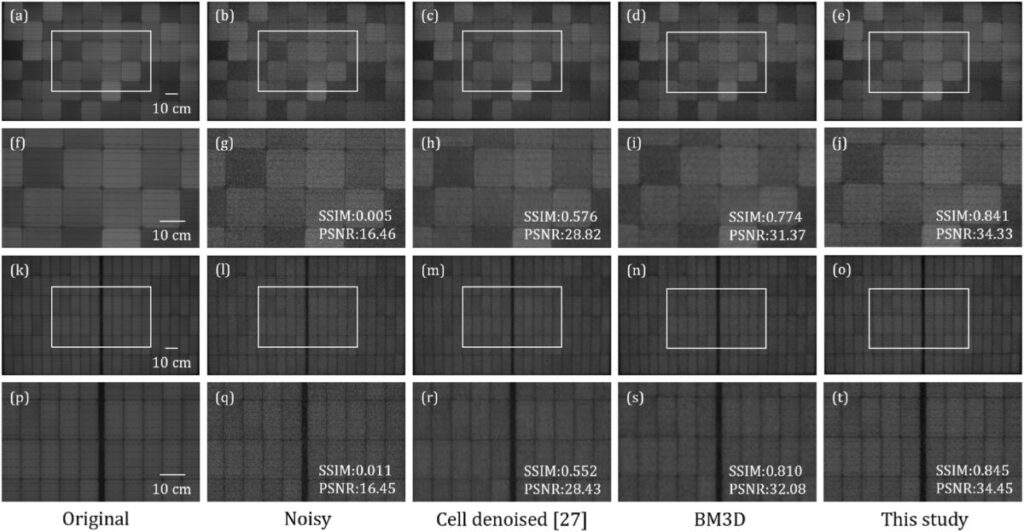Researchers in Australia have developed a simplified remaining network-based architecture method to filter noise from electroluminescentry images of PV modules. The proposed technology is said to improve the accuracy and efficiency of automated inspection systems for PV plants on utilities.
A group of scientists, led by researchers from the University of New South Wales (UNSW) in Australia, has developed a new deplication method for denoizing outdoor electroluminescence (EL) images of PV modules.
Dubbeds Simpleresnet, the new method is based on a simplified architecture based on Resnet (Resnet), which uses remaining connections to be able to learn neural networks more effectively.
“By using an adapted computer vision model, with a deep convolutional neural network architecture, we are able to improve the quality of denoising for imaging data sets, in particular by maintaining important high-contrast image characteristics that are crucial for diagnostic analysis,” said the corresponding author Brendan Wrightt PV -Magazine. “The performance of our methodology exceeds earlier attempts and more general denoising -algorithms.”
The new methodology consists of an input conventional layer with eight filters, a single residual block and an output conventional layer. The remaining block, in turn, contains two 3 × 3 convolutional layers with eight filters each. The model was trained, validated and tested on 627 images, with a ratio of 7: 2: 1.
The dataset consisted of grayscale luminescentry images of full cell and half-cell monocrystalline PV modules, recorded indoors with a preference of 100% and 10% of the short-circuit current of the module. Three types of sounds-gausian, Poisson and salt-and-pepper-Werden added to those images, alone and together, using mathematical models. Finally, noisy image pairs were combined for using the model.
Image: University of New South Wales, Solar Energy Materials and Solar Cells, CC by 4.0
“For benchmark comparison, the BM3D algorithm, an ultramodern traditional denoising method was used. The sound standard deviation parameter in BM3D, which controls the strength of Denoising, was set on 160/255 for optimum performance,” said the scientists. “Moreover, the results were compared to the DENNET34-based denoising model at cell level. Although this model was designed and trained for individual PV cells, it was adjusted here to process full module images, which emphasizes the urgent need for special module level solutions.”
The Simpleresnet architecture turned out to be a better denoising performance than the benchmarks. It has reached an average peak signal -noise ratio (PSNR) value of 33.56 dB and a structural agreement index size (SSIM). BM3D, on the other hand, achieved 31.48 dB and 0.80 respectively, while the denoizing approach at cell level reached 28.42 dB and 0.62 respectively. “These developed possibilities contribute to improving the accuracy and efficiency of automated inspection systems for PV factories on utility scale,” the academics noted.
The analysis also showed that the processing speed of the method was less than 0.2 seconds per image. “We reach a dramatic calculation time/cost benefit when using this more targeted model, which reduces the time for processing one image to less than 1 second, a order of size improvement compared to the BM3D algorithm reference, making this method feasible for real-time processing applications.
“We are planning to continue to optimize the performance of this class models, through improvements in architecture and training methods, but also to concentrate on generalization and application on additional diagnostic imaging techniques, including infrared and photoluminescence image, where we have already seen promising results. “We expect our general machine learning methodology to make considerable progress in monitoring and analysis of solar module, with a positive and practical impact on industry.”
The new technology was presented in “Robust denoizing methodology for exterior dependence images of photovoltaic modules using deep learning“Published in Solar energy materials and solar cells. Scientists from the University of New South Wales in Australia and the Technical University of Denmark worked together.
This content is protected by copyright and may not be reused. If you want to work with us and reuse part of our content, please contact: editors@pv-magazine.com.
Popular content


